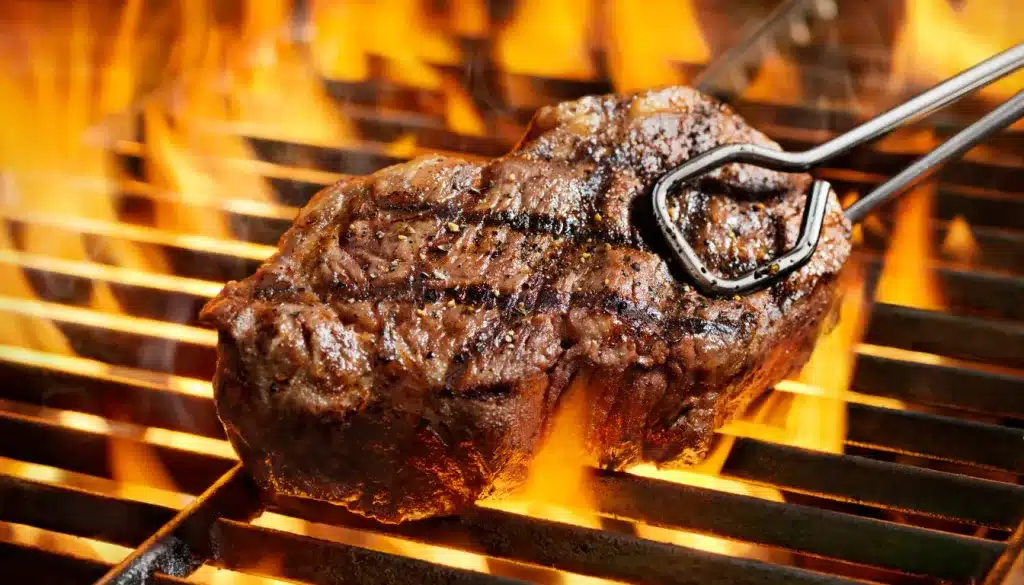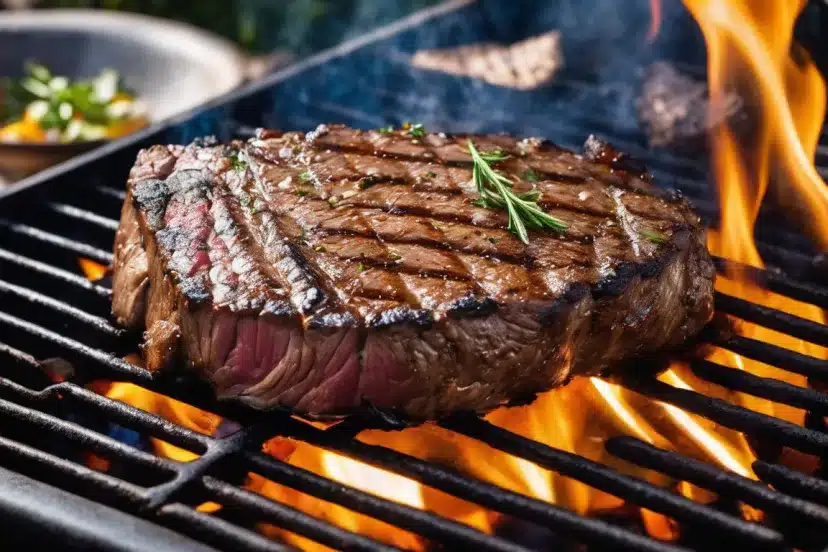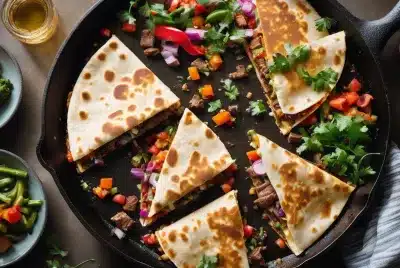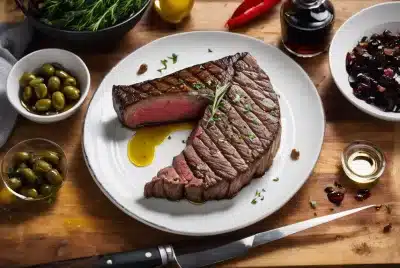The Ultimate Guide to Cooking and Enjoying Blue Rare Steak
Steak enthusiasts, have you ever been curious about that “blue rare” steak on the menu but felt a tad hesitant to try it? Maybe you’ve heard hushed tales of its bold taste and unique texture but aren’t quite sure if it’s for you—or even what exactly sets it apart from the typical rare steak.
It’s time to demystify one key fact: blue rare steak is an experience of its own, characterized by being seared on the outside and still very red, almost purple, inside with an internal temperature of about 115°F.
In this ultimate guide, we’re slicing through any confusion and laying out all the juicy details for cooking and savoring a perfect blue rare steak. From selecting top-notch cuts to mastering the grill or stove-top techniques required for that ideal level of doneness, this article is your secret recipe.
If you’ve longed for tender meat that melts in your mouth with minimalistic cooking yet maximum flavor payoff, then get ready! We’ll ensure your next blue steak isn’t just safe to eat; it will be unforgettable.
Get your forks ready!
Table of Contents
- 1 Understanding Blue Rare Steak
- 2 How to Cook Blue Rare Steak
- 3 What Does Blue Rare Steak Taste Like?
- 4 Conclusion
- 5 FAQs
- 5.1 1. What is a blue rare steak?
- 5.2 2. Is cooking blue rare steak safe to eat?
- 5.3 3. How do I cook the perfect blue-rare steak?
- 5.4 4. What should I know about eating a blue rare steak compared to a regular rare steak?
- 5.5 5. Can you give me tips for adding flavor when cooking my own ultimate guide on how to enjoy my perfect Blue Rare Steak at home?
Key Takeaways
- Blue rare is seared outside and nearly raw inside, reaching an internal temperature of around 115°F.
- To cook blue rare steak safely, choose high-quality cuts like filet mignon or ribeye and handle the meat with care.
- Cook blue rare beef on a very hot grill for 1–2 minutes per side to keep the inside cool and tender.
- The best cuts for this steak are thick and well marbled; avoid thin or less marbled meats that can overcook easily.
- Blue rare steak has a bold, beefy flavor and a soft texture that feels almost creamy in the mouth.
Understanding Blue Rare Steak
Blue steak, also known as blue rare steak, is a lightly seared piece of meat where the outside is cooked, but the inside remains nearly raw. It’s safe to eat if properly handled and can offer a unique and flavorful experience for steak enthusiasts.
What is Blue Steak?
Blue steak is a type of steak that’s cooked very briefly. It’s seared on the outside but left almost completely raw inside. Meat lovers savor its tenderness and flavor. The key to this steak is its low internal temperature, which should reach around 115°F, just enough to warm it up without cooking it through.
To get that perfect blue steak doneness, use high heat for a very short time.
Cooking and enjoying this level of rareness requires skill and an appreciation for beef’s natural taste. Not all cuts are good for blue steak; you want ones that are tender, like filet mignon or ribeye.
Chefs often bring the meat to room temperature before searing it quickly on each side, locking in the juices with a flavorful crust.
Is it Safe to Eat?
This steak, which is cooked to a very low internal temperature of 84 degrees F, is safe for consumption as long as it’s prepared with care and from high-quality meat. When handled correctly, the risk of foodborne illness is minimal.
It should be noted that because the steak is barely cooked, it’s imperative to ensure that proper handling and cooking techniques are followed to reduce any potential health risks associated with consuming undercooked meat.
Enjoying this kind of steak requires an understanding and appreciation of its unique flavors and textures, which are appreciated by dedicated meat lovers who enjoy the distinct taste of rare beef.
Eating this rare steak involves savoring its tender texture achieved at around 115°F internal temperature while being aware that precision in cooking this particular cut demands a love for culinary finesse.
Why Should You Try It?
Now that you know it is safe to eat and how to cook it, you should try it because the unique flavor and texture profile offer a delightful experience for dedicated meat lovers.
The intense beefy taste combined with the tender, juicy texture of blue rare steak creates an unparalleled sensory delight. Trying it allows you to experience the pure essence of high-quality beef in its most unadulterated form, providing a true appreciation for meat at its finest.
This culinary adventure is perfect for those seeking an elevated and unique gastronomic journey beyond traditional steak experiences.
Where to Find Blue Steak in Dallas
In Dallas, rare steak enthusiasts can savor the unique experience of blue steak at upscale steakhouses renowned for their dedication to perfecting meat. Additionally, specialty butcher shops known for high-quality cuts also offer blue rare options for those who prefer preparing this delicacy at home.
These establishments source premium beef and follow precise cooking methods to ensure a truly exceptional blue rare steak experience.
For the best dining or cooking experience in Dallas, seeking out these reputable steakhouses and butcher shops is essential. By understanding where to find top-notch blue rare steak, you can indulge in this exquisite culinary delight with confidence and satisfaction.
How to Cook Blue Rare Steak

Achieving the perfect rare steak involves cooking it at a very high temperature for a short amount of time, ensuring that the interior is still cool and nearly raw. Read on to discover the best cuts and techniques for cooking this tender and flavorful dish!
What temperature should I cook it at?
Cook it to a very low internal temperature of 84 degrees F, while it should be around 115°F for rare beef. This precision cooking requires skill and appreciation for the unique flavors of rare beef.
The first step is choosing the right meat cut, ensuring that it’s brought to room temperature before cooking. For blue rare steak at its finest, consider using an oven set at 100 degrees for about 5 minutes.
Now let’s explore the best cuts for this steak and techniques for cooking on a grill.
Best cuts for blue steak

When considering the best cuts for blue steak, opt for tender and well-marbled options like ribeye, sirloin, or filet mignon. These cuts are ideal due to their tenderness and ability to retain juiciness at the low cooking temperatures required for it.
Selecting a high-quality cut of meat is essential to ensure a flavorful and enjoyable experience. Additionally, these cuts can be easily seasoned and grilled to perfection according to your preferences.
When it comes to choosing the right cut for preparing this steak, remember that marbling plays a crucial role in preserving moisture and enhancing flavor as the beef cooks. Prime-grade cuts often offer superior marbling compared to select or choice grades.
Cuts to avoid for blue rare
Avoid using thin cuts like minute steak or skirt steak for blue rare, as they may overcook too quickly. Stay away from tenderloin or filet mignon, which can become dry at such low temperatures.
Opt for thicker, more marbled cuts like ribeye or sirloin to ensure a juicy and flavorful blue rare steak experience. It’s essential to choose the right cut to achieve the perfect balance of tenderness and rich flavor in your steak.
Techniques for cooking on grill
Cooking one on the grill requires high heat and quick cooking. Preheat the grill to its highest setting for at least 10 minutes before cooking. Use a cut with good marbling, like ribeye or sirloin, and pat it dry before seasoning generously with salt and pepper.
Place the steak on the hottest part of the grill for 1-2 minutes per side, creating a flavorful crust while keeping the inside rare. Let it rest for a few minutes before serving to allow juices to redistribute, ensuring a tender and juicy steak.
Ensure that your grill is clean and well-oiled to prevent sticking, which can cause tearing of the delicate meat fibers in this style of steak preparation. Avoid pressing down on the steak while grilling; this will only force out precious juices and result in a drier finished product better suited for medium-rare or medium doneness steaks.
Tips for achieving desired level of doneness
Achieving the perfect level of doneness for blue rare steak requires precision. Use a meat thermometer to ensure the internal temperature reaches around 115°F, and let it rest before slicing.
Select a high-quality cut like tenderloin or ribeye, bring it to room temperature before cooking, and avoid over-seasoning to let the natural flavors shine. When grilling, sear each side for a short time or gently cook in an oven at low heat until reaching the desired doneness.
Enjoy this unique steak experience with simple seasonings that complement its rich flavor profile.
What Does Blue Rare Steak Taste Like?
It offers a bold, beefy flavor with a tender texture that melts in your mouth, making it an indulgent experience for steak enthusiasts. Curious to learn more about this unique cooking method? Keep reading to find out how to cook and enjoy blue rare steak like a pro!
Flavors and textures
It offers a unique flavor profile, with a robust and rich beefy taste. The texture of blue rare steak is incredibly tender, with a juicy and almost creamy mouthfeel due to its minimal cooking time.
The seared exterior provides a satisfying crunch, while the center remains cool and velvety, providing an unparalleled sensory experience for true meat enthusiasts. Enjoying the flavors of this steak requires an appreciation for the pure essence of high-quality beef, making it a delightful indulgence for those seeking an authentic and unadulterated steak experience.
Rare steak lovers can savor the distinct umami undertones present in blue rare steak, accompanied by a melt-in-your-mouth sensation that only comes from such perfectly cooked meat.
Conclusion
In conclusion, mastering the art of cooking and enjoying blue rare steak involves precision, skill, and an appreciation for the unique flavors of rare beef. The ultimate guide has provided insights into selecting the right cuts of meat and achieving perfect doneness through careful temperature control.
By implementing these practical tips, you can elevate your steak-cooking game and savor an exceptional culinary experience. Embracing the challenge of cooking blue rare steak can lead to a newfound understanding and enjoyment of this delicacy.
Explore further resources to enhance your skills in preparing and relishing this tender delight. Let your journey to culinary excellence begin!
FAQs
1. What is a blue rare steak?
It is a very tender steak that’s grilled for only a short time, so it has an internal temperature lower than most steaks and keeps its red color.
2. Is cooking blue rare steak safe to eat?
Yes! If you ensure the outside of the steak reaches a high heat to kill bacteria, enjoying this rare steak can be safe.
3. How do I cook the perfect blue-rare steak?
To cook the ultimate steak, sear it quickly on high heat until it reaches an internal temperature appropriate for this level of doneness, and let it rest before serving.
4. What should I know about eating a blue rare steak compared to a regular rare steak?
The main difference between eating this kind of steak versus a regular rare one is how little they’re cooked; the blue one feels cooler and softer because of its brief grilling time.
5. Can you give me tips for adding flavor when cooking my own ultimate guide on how to enjoy my perfect Blue Rare Steak at home?
Sure! For extra taste with your grilled tender cut, try marinating or seasoning it before you grill it, following our top recipes from The Ultimate Guide to Cooking and Enjoying Blue Rare Steak.
*We may earn a commission for the purchases made using our links. Please see our disclosure to learn more.




